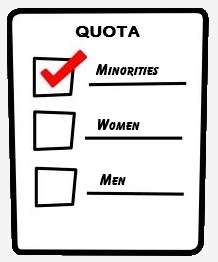Discrimination vs. Reverse
Discrimination

There has emerged an alarming trend
regarding the use of the word “discrimination,” one that repeatedly
misapplies this term. Multiple laws (such as Title IX) and policies
(such as affirmative action) which were designed to remedy problems
resulting from discrimination have come under attack from those who
claim they fail, because they are, themselves, discriminatory—in fact,
they’re often seen as involving “reverse discrimination.”
Eliminating discrimination
= automatic reverse discrimination?
In other words, they claim that
efforts to eliminate discrimination in and of themselves are a form of
discrimination, in this case "reverse discrimination."
Almost relishing the fact that they
can hoist these laws and policies by their own petards, some opponents to
them misuse the concept of “discrimination” in their effort to
remove them.
But eliminating discrimination in and
of itself
hasn't been the goal:
Let’s start by acknowledge that of course these laws and policies are
discriminatory. They were never intended not to be. In fact, there has
never been a goal of removing discrimination from the social landscape.
No one has ever sought to eliminate
discrimination as part of the process of advancing people in
our society. Hiring, admission to colleges and universities, salary
increases, allocation of funding, to name a few, all
involve some act of discrimination, often based on the notion of "merit." Otherwise, we just draw names out
of a hat.
Eliminating biased
discrimination, now that's another matter
To see what truly was and continues
to be the intent in addressing discrimination, all we need do is
remember that the issue is "biased discrimination." But, for
convenience, we don’t use the entire phrase. So when we say we are
trying to eliminate discrimination, we are referring solely to biased
discrimination, not discrimination in general. We are referring to
that sort of discrimination that fails to do what it is supposed to do,
help us make appropriate choices.
Sources of bias:
There are many ways in which the
process of discrimination can be flawed and biased. If those who
are making the discrimination, refuse to take into account all relevant factors,
ignore issues of merit, are biased to select on the basis of
stereotypes, prejudice and personal preference, or even quotas, then the discrimination can be flawed. It can be
unfair. And it can fail not only to provide equal opportunity but to
squander human resources that can benefit society.
Want to read more about biases?
We have several pages on our web site dealing with this topic.
Equal Opportunity
That's the goal. Efforts to
eliminate biased discrimination have focused on providing equal
opportunity. And we all benefit from that, because in the end it
means the most able and qualified advance.
Reverse Discrimination
Now there is a form of biased
discrimination (one of those listed above) that is what people are
calling "reverse discrimination," but it is NOT the automatic result of
efforts to deal with biased discrimination.
It comes from how
folks try to eliminate biased discrimination. It is the use of
quotas. In an effort to reduce, or eliminate biased
discrimination, some have resorted to the strategy of using a quota--it's
quick, it's simple, and it doesn't require any sophisticated assessment
processes, it just says things like,:
"We need a certain number of employees to be women/minority/etc."
There are those who see this as biased, reverse discrimination, and the current
Supreme court has tended to agree.
 To
read about more about Equal Opportunity
To
read about more about Equal Opportunity
 To
go to the brief introduction to Hot Topics
To
go to the brief introduction to Hot Topics
 To
go to the Articles Page
To
go to the Articles Page